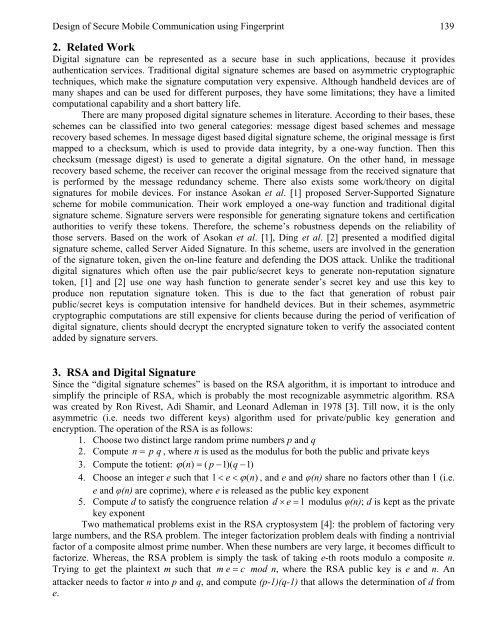Design of Secure Mobile Communication using Fingerprint
Design of Secure Mobile Communication using Fingerprint
Design of Secure Mobile Communication using Fingerprint
You also want an ePaper? Increase the reach of your titles
YUMPU automatically turns print PDFs into web optimized ePapers that Google loves.
<strong>Design</strong> <strong>of</strong> <strong>Secure</strong> <strong>Mobile</strong> <strong>Communication</strong> <strong>using</strong> <strong>Fingerprint</strong> 139<br />
2. Related Work<br />
Digital signature can be represented as a secure base in such applications, because it provides<br />
authentication services. Traditional digital signature schemes are based on asymmetric cryptographic<br />
techniques, which make the signature computation very expensive. Although handheld devices are <strong>of</strong><br />
many shapes and can be used for different purposes, they have some limitations; they have a limited<br />
computational capability and a short battery life.<br />
There are many proposed digital signature schemes in literature. According to their bases, these<br />
schemes can be classified into two general categories: message digest based schemes and message<br />
recovery based schemes. In message digest based digital signature scheme, the original message is first<br />
mapped to a checksum, which is used to provide data integrity, by a one-way function. Then this<br />
checksum (message digest) is used to generate a digital signature. On the other hand, in message<br />
recovery based scheme, the receiver can recover the original message from the received signature that<br />
is performed by the message redundancy scheme. There also exists some work/theory on digital<br />
signatures for mobile devices. For instance Asokan et al. [1] proposed Server-Supported Signature<br />
scheme for mobile communication. Their work employed a one-way function and traditional digital<br />
signature scheme. Signature servers were responsible for generating signature tokens and certification<br />
authorities to verify these tokens. Therefore, the scheme’s robustness depends on the reliability <strong>of</strong><br />
those servers. Based on the work <strong>of</strong> Asokan et al. [1], Ding et al. [2] presented a modified digital<br />
signature scheme, called Server Aided Signature. In this scheme, users are involved in the generation<br />
<strong>of</strong> the signature token, given the on-line feature and defending the DOS attack. Unlike the traditional<br />
digital signatures which <strong>of</strong>ten use the pair public/secret keys to generate non-reputation signature<br />
token, [1] and [2] use one way hash function to generate sender’s secret key and use this key to<br />
produce non reputation signature token. This is due to the fact that generation <strong>of</strong> robust pair<br />
public/secret keys is computation intensive for handheld devices. But in their schemes, asymmetric<br />
cryptographic computations are still expensive for clients because during the period <strong>of</strong> verification <strong>of</strong><br />
digital signature, clients should decrypt the encrypted signature token to verify the associated content<br />
added by signature servers.<br />
3. RSA and Digital Signature<br />
Since the “digital signature schemes” is based on the RSA algorithm, it is important to introduce and<br />
simplify the principle <strong>of</strong> RSA, which is probably the most recognizable asymmetric algorithm. RSA<br />
was created by Ron Rivest, Adi Shamir, and Leonard Adleman in 1978 [3]. Till now, it is the only<br />
asymmetric (i.e. needs two different keys) algorithm used for private/public key generation and<br />
encryption. The operation <strong>of</strong> the RSA is as follows:<br />
1. Choose two distinct large random prime numbers p and q<br />
2. Compute n = p q , where n is used as the modulus for both the public and private keys<br />
3. Compute the totient: ϕ ( n)<br />
= ( p −1)(<br />
q −1)<br />
4. Choose an integer e such that 1 < e < ϕ(<br />
n)<br />
, and e and φ(n) share no factors other than 1 (i.e.<br />
e and φ(n) are coprime), where e is released as the public key exponent<br />
5. Compute d to satisfy the congruence relation d × e = 1 modulus φ(n); d is kept as the private<br />
key exponent<br />
Two mathematical problems exist in the RSA cryptosystem [4]: the problem <strong>of</strong> factoring very<br />
large numbers, and the RSA problem. The integer factorization problem deals with finding a nontrivial<br />
factor <strong>of</strong> a composite almost prime number. When these numbers are very large, it becomes difficult to<br />
factorize. Whereas, the RSA problem is simply the task <strong>of</strong> taking e-th roots modulo a composite n.<br />
Trying to get the plaintext m such that m e = c mod n, where the RSA public key is e and n. An<br />
attacker needs to factor n into p and q, and compute (p-1)(q-1) that allows the determination <strong>of</strong> d from<br />
e.
















